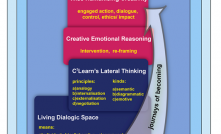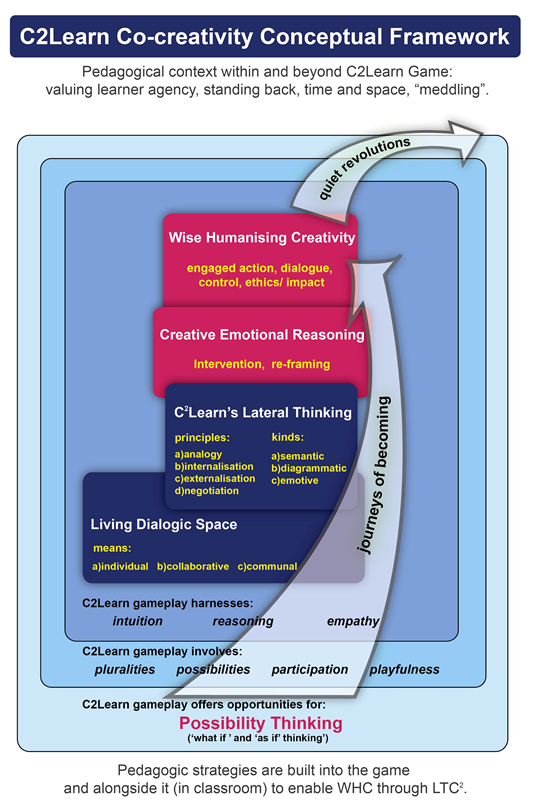
Creativity within C2Learn emphasises collaborative and communal activity (co-creativity) whilst recognising the role of the individual. C2Learn co-creativity involves novelty emerging through a process of ‘possibility thinking’ (PT) – the transition from what is to what might be through ‘what if’ thinking (enquiry) and ‘as if’ thinking (imagining). Inherent within C2Learn co-creativity is attention to impact of creative outcomes in terms of the immediate and wider context. This ethically framed creativity therefore foregrounds the role of values in generating fundamental small-scale creative change (quiet revolutions). This conceptualisation also attends to how creative activity generates change in the makers as well as change by the makers (a process of becoming through making and being made). This ethically framed co-creativity or wise, humanising creativity (WHC) involves within it, creative emotional reasoning (CER).
CER is an umbrella term and refers to: a principled, unifying theory of non-linear thinking techniques that foster co-creativity within C2Learn’s computational tools. (C2Learn’s Lateral Thinking [LTC2] refers only to the theoretical part). CER is premised on a notion of creativity as an intervention resulting in reframing. Intervention involves ‘stepping into’ C2Learn participants’ thinking and creative process in order to change how the participants are thinking and acting. With CER embedded within a set of creative learning tools (different LTC2 techniques implemented in C2Learn’s computational tools) the aim is to disrupt established routines and patterns.
With this role CER is embedded within WHC to foster co-creativity. The aim is to seek an organic fusion that will provide WHC with additional structured techniques taking advantage of and further enabling WHC’s creativity opportunities. And in return CER is housed within a much-needed ethical and cultural framework and the most appropriate conditions for fulfilling its potential.
Developed theoretically alongside WHC is the idea of Living Dialogic Space (LDS). These spaces are characterised by debate and difference, openness to action, working ‘bottom up’, and different modes of idea exchange, and have been connected in previous projects with the facilitation of WHC. LDS’ will be embedded in the game and also present in the environment outside the game to offer players high participation and shared control, individually, in collaboration and/or as part of a communal endeavour. Within and outside the C2Learn game-world interactions these spaces will be facilitated through creative learning conversations. The purpose of these is to flatten hierarchies, reposition players in different roles and allow spaces that promote a sense of equality through ‘listening’ to other players and even allow players to change their mind by identifying with the space of dialogue.
As CER heavily relies on brainstorming activities structuring the core parts of LTC2 techniques, there is a particular relation with LDS. LDS’ flattened hierarchies, manifested in an open space of dialogue, are an ideal environment within which to embed and evolve these brainstorming techniques, providing the opportunity to experiment with dynamic group management methods.
Within and outside of the C2Learn game-world, CER’s set of core creative learning tools will thus support the manifestation of WHC which fuels the potential for quiet revolutions, the ultimate intention of the C2Learn process. The relationships between WHC and CER and their contribution to quiet revolutions, is shown in the Figure below which is reproduced from the first iteration of the project’s learning design deliverable (July 2013). This seeks to show how quiet revolutions are ethically grounded as well as critical, aligning personal with wider values. A quiet revolution, emerging in and beyond the C2Learn game-world through collaborative and collective endeavour, is also grounded in excellence and engaged involvement from children and adults in the learning space.

The Figure above shows C2Learn Co-Creativity, as emerging from the centre of the figure comprising the two related components discussed above, i.e. Wise Humanising Creativity (WHC) and Creative Emotional Reasoning (CER). As indicated in the learning design deliverable, co-creativity will manifest in five intertwined ways shown in the highlighted box within the WHC and CER sections of the graphic. Game-players will:
- Generate, explore and enact new ideas with a valuable impact on the community, discarding other ideas that lack such potential (ethics and impact)
- Pose questions, debate between new ideas, find ways to negotiate conflict or to go in a different direction to others if conflict is not resolved (dialogue)
- Take charge of different parts of the creative process, understanding the rules of the system and how decisions have consequences, making decisions around new ideas and taking action(s)[6] through various scenarios and/or quests (control)
- Be immersed in the game and its environment, and possibly addicted to gameplay and/or the interactive drama played out in the game-world and in real-world spaces. Such immersion will sometimes lead to taking risks and generating surprising individual or collaborative ideas (engaged action)
- Have their thinking and action disrupted by the game’s computational tools embedded within which are CER non-linear thinking techniques. This will them move them away from established routines and patterns (intervention resulting in reframing)
It is important to note that such activity is about these five elements in combination making more than the sum of their parts in order to generate co-creativity. This is about new ideas which are captured or selected because they are valuable to the community, and are generated with shared control in an immersed dialogic environment, fostering ethical awareness arising from the experience.
The key outstanding elements embedded within the environment are the 4Ps: pluralities (opportunities for learners to experiment with multiple pluralities of places, activities, personal identities, and people), possibilities (opportunities for possibility thinking, transitioning from what is to what might be, co- constructing with others through the C2Learn experience, designing, editing, extending and exploring content), participation (opportunities for learners to take action, make themselves visible on their own terms, and act as agents of change) and playfulness (opportunities for players to learn, create and self-create as active and connected players in their emotionally rich, virtual and actual play-worlds).
Over time, noticeable changes in players’ dispositions, even small incremental personal changes, will result from their WHC. This is because there is a core reciprocal relationship within WHC between creativity and identity in which as creators make, they are also being made. And so players undertake journeys of becoming. This is represented on the figure as an embedded on-going process from the ‘how’ of the enablers of co-creativity to the ‘what’ of the co-creativity.

